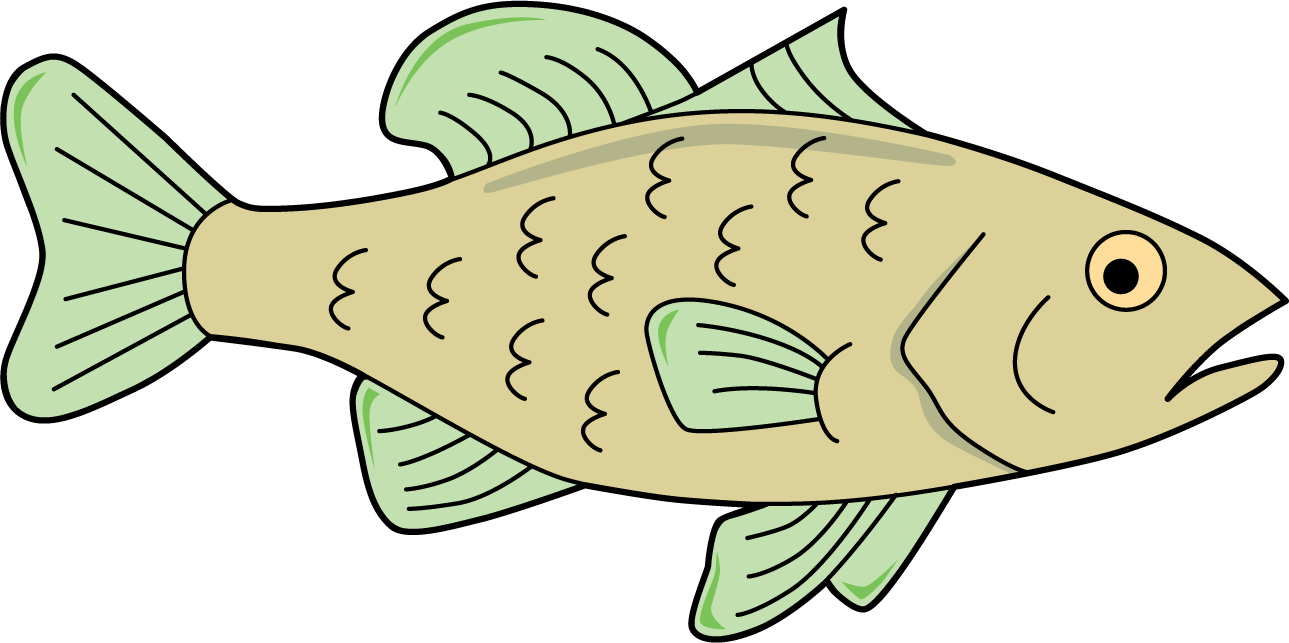Lesson 9
From Feet to Inches
Warm-up: Estimation Exploration: Small Fry, Big Fish (10 minutes)
Narrative
The purpose of this Estimation Exploration is for students to practice the skill of estimating a reasonable length based on their experience and known information. They are given an illustration of a boy and a fish and are asked to give an estimate for the length of the fish in inches. This gives students an opportunity to share a mathematical claim including the assumptions they made when interpreting the image with limited information (MP3, MP4). After students are given more information, they have an opportunity to revise their estimates.
Launch
- Groups of 2
- Display the image.
- “About how long do you think the fish in the picture is in inches?”
- “What is an estimate that’s too high? Too low? About right?”
- 1 minute: quiet think time
Activity
- “Discuss your thinking with your partner.”
- 1 minute: partner discussion
- Record responses.
- “We had a lot of different guesses, because we don’t have a lot of information.”
- “The boy is 7 years old. He is 48 inches tall.”
- “Based on this new information, do you want to revise or change your estimates?”
- 1 minute: quiet think time
- 1 minute: partner discussion
- Record responses.
Student Facing
How long is this Cobia fish in inches?

- Record an estimate that is:
too low about right too high \(\phantom{\hspace{2.5cm} \\ \hspace{2.5cm}}\) \(\phantom{\hspace{2.5cm} \\ \hspace{2.5cm}}\) \(\phantom{\hspace{2.5cm} \\ \hspace{2.5cm}}\) - Record an estimate that is:
too low about right too high \(\phantom{\hspace{2.5cm} \\ \hspace{2.5cm}}\) \(\phantom{\hspace{2.5cm} \\ \hspace{2.5cm}}\) \(\phantom{\hspace{2.5cm} \\ \hspace{2.5cm}}\)
Student Response
For access, consult one of our IM Certified Partners.
Activity Synthesis
- “How did you revise your estimate when you found out how old the boy was and his height?” (My first estimate was a lot higher, but it looks like if this fish was touching the ground too, they'd be closer to the same length. The fish looks about 20 inches higher or longer, but it isn’t touching the ground. I did 12 more inches, which is 60.)
- If it doesn’t come up, point out that the fish is not touching the ground.
Activity 1: Measure the Length of Fish (20 minutes)
Narrative
The purpose of this activity is to introduce the foot as a length unit in the U.S. customary system. Students learn that a foot is longer than an inch and is the same length as 12 inches. They use the length of 12-in rulers as a tool to measure lengths in feet by iterating the length of a ruler, or, more precisely, the length of 12 inches shown on the ruler. The experience iterating lengths of a ruler to measure a length in feet helps students build a mental benchmark for the approximate length of a foot that they can use to estimate lengths.
Students measure lengths of tape that represent realistic lengths of different types of fish. They measure each length to the nearest inch and to the nearest foot. In the synthesis, students discuss the difference in their measurements and relate the differences to the size of the length units (MP7).
Advances: Conversing, Reading
Required Materials
Materials to Gather
Required Preparation
- Tape strips of these lengths on the floor. Label each strip with the letter and fish name. It may be helpful to make multiple sets of these lines to keep the groups small.
- Strip A, largemouth bass: 2 feet
- Strip B, spiny dogfish shark: 4 feet
- Strip C, catfish: 3 feet
- Strip D, koi: 2 feet and 6 inches
Launch
- Groups of 3–4
- Give each student an inch ruler and access to inch tiles.
- “You have measured the length of objects and the sides of shapes using inches. If you are measuring longer objects, like the fish in the warm-up, you might want to use a different unit.”
- “A foot is a longer length unit in the U.S. Customary Measurement System. A foot is the same length as 12 inches.”
- “When we measure a length that starts at 0 on the ruler and ends at the 12, we can say the length is 12 inches or we can say the length is 1 foot.”
- “What are some things you see around the classroom that are about 1 foot long?"
- 30 seconds: quiet think time
- Share responses.
Activity
- Display the images of the fish.
- “In previous lessons, we measured the lengths of different kinds of reptiles. In this lesson, you will be measuring the lengths of fish. What do you know about fish?”
- Share responses.
- “Let’s imagine we work at the aquarium and need to measure the lengths of these fish. The tape on the floor represents their lengths.”
- “Look at the tape strips on the floor. Use your rulers to measure each length first in feet. Then measure the length in inches using the rulers or your inch tiles.”
- 10 minutes: group work time
- As needed, pause after students have measured their first fish in feet and invite students to share how they used their rulers to measure in feet.
Student Facing
-
Work with your group to measure the tape strips around the classroom in feet. Then measure the length in inches.
Tape A
largemouth bass

Length in feet: __________
Length in inches: __________
Tape B
spiny dogfish shark

Length in feet: __________
Length in inches: __________
Tape C
catfish

Length in feet: __________
Length in inches: __________
Tape D
koi

Length in feet: __________
Length in inches: __________
- What did you notice about the number of feet compared to the number of inches when you measured the tape strips?
Student Response
For access, consult one of our IM Certified Partners.
Advancing Student Thinking
If students measure lengths in feet by lining up multiple rulers or iterating the same ruler without considering gaps that may be caused by the lengths of the ruler before the 0 in or after the 12 in mark, point out these gaps on the ruler and consider asking:
- “Can you show me how you measured the length of the ______ in feet?”
- “Did you measure the length without any gaps? How do you know?”
- “How would you revise the way you measure to make sure you have no gaps or overlaps?”
Activity Synthesis
- “What did you notice about your measurements when you switched from measuring in feet to measuring in inches?” (The numbers are smaller for the number of feet. I had to count more inches than feet.)
- “Why are our measurements in feet so much smaller than our measurements in inches?” (Feet are longer, so you don't need as many to measure the length of the tape. It takes more inches to cover the same length.)
Activity 2: Inches or Feet? (15 minutes)
Narrative
The purpose of this activity is for students to make decisions about the length units and tools they use when measuring the lengths of objects (MP5). Monitor for the reasons students give for choosing their length unit or tool based on the length of the object they are measuring. When measuring items that are not a whole number of feet long, encourage students to consider using feet and inches to build their understanding that the length units are part of the same system of measurement.
In addition to inch tiles and rulers, it is recommended that students use a retractable measuring tape (tape measure) that marks the length of each foot. If measuring tapes are not available, students may use yardsticks or other tools that are longer than 12-inches. Keep in mind that if your “yardstick” is the same as your meterstick, it is longer than 36 inches and may not indicate the length of each foot. If these tools do not mark the length of each foot, take the time before measuring to show students how to use a ruler to check the length of each foot. If possible, label the length of each foot on the tool before students begin measuring.
Supports accessibility for: Organization, Conceptual Processing
Required Materials
Materials to Gather
Required Preparation
- Each group of 4 needs a measuring tape (or retractable tape measure) that labels the length of each foot.
Launch
- Groups of 2 and 4.
- Give each student an inch ruler and access to inch tiles.
- Give each group a measuring tape.
- “There are other tools you could use to measure even longer lengths in inches and feet.”
- Hold up a measuring tape.
- “A measuring tape can be used to measure longer lengths in inches. Some measuring tapes also show the length of each foot.”
- Point out the different labels that show inches and those that indicate feet.
- As needed, display the proper use of a retractable measuring tape (tape measure).
- As needed, display and describe the features of any other tools for measuring that students may have access to for the activity (for example, yardsticks) and how they may be used to measure inches or feet.
Activity
- “Now you are going to measure a few objects around the room, but before measuring each item you will make an estimate in inches or feet.”
- “For each item, record your estimate, and circle inches or feet.”
- “After you and your partner have made your estimates, compare to see if you agree.”
- 5 minutes: partner work time
- “Now choose a measuring tool to measure each of the same objects and record the actual lengths. Don’t forget to include the unit.”
- 5 minutes: small-group work time
- Monitor for students who use measuring tape to measure in feet, inches, or both units.
Student Facing
- Estimate the length of objects around the room. Say if you will measure in inches or feet.
object to measure my estimate circle inches or feet inches
feet
inches
feet
inches
feet
inches
feet
- Choose the best tool to measure each object. Complete the table to record your actual measurements.
| object to measure | measurement tool | actual length (include unit) |
|---|---|---|
Student Response
For access, consult one of our IM Certified Partners.
Activity Synthesis
- “After you picked an object to measure, how did you decide whether to measure in inches or feet?”
- “How did you decide what tool you would use to measure the length of the object?”
- Invite previously identified students who used feet and inches to measure a longer length with greater precision.
Lesson Synthesis
Lesson Synthesis
“Today, you practiced measuring in inches and feet. What did you notice about the number of feet in comparison to the number of inches when you measured the tape strips?” (There were more inches, because inches are a lot smaller than feet.)
“Do you think it will always be true that it takes more smaller units than larger units to measure length?” (Yes, because longer units get to the end of the object before the shorter ones. It happened with cm and meters and with in. and ft.)
Share and record responses.
Cool-down: Measure in Inches and Feet (5 minutes)
Cool-Down
For access, consult one of our IM Certified Partners.